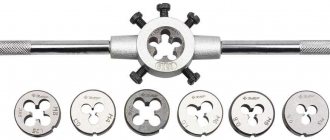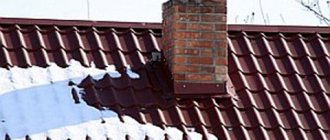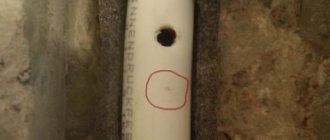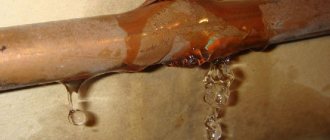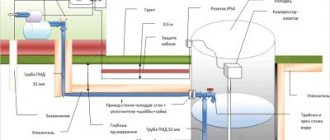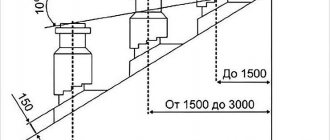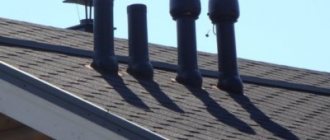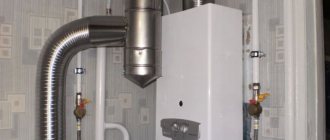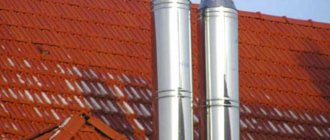Chimney damper
One of the main conditions for the efficiency of a heating system is the quality of draft. To regulate air flows, a damper is used - a simple-shaped metal valve mounted in the smoke exhaust duct. The damper is considered a mandatory element of the chimney and is sold along with it, but for homemade stoves the damper can be purchased separately. In addition, it is not difficult to make and install a gate valve on your own if you familiarize yourself with the technology in detail.
Chimney damper
How is traction adjusted?
The damper plate follows the cross-section of the chimney and, when closed, almost completely blocks the chimney. A small hole in the valve does not allow the pipe to be hermetically sealed, which meets fire safety requirements. By changing the position of the damper, you increase the air flow, and, accordingly, the flame in the furnace burns hotter. Reduce the gap - the draft decreases, the fire burns weaker. When the flame in the firebox dies out, the damper is closed to retain heat. If you don't do this, the oven cools down much faster.
What is a gate
The latest modifications of stoves are equipped with deflectors that automatically regulate draft. All other heating devices require the installation of gate valves.
Gate prices
How to adjust traction
The design of the rotary damper contains a plate that follows the cross-section of the chimney and covers it in the closed position. Fire safety regulations prohibit complete sealing of the pipe. As the position of the plate changes, the flow of air masses increases or decreases, contributing to the intensity of flame combustion in the firebox. After the fire in the stove dies out, the valve must be closed. This will keep the temperature in the combustion chamber high. Otherwise, all the heat will literally “fly down the drain.”
Types of gate
Retractable
The retractable type gate is considered the most convenient and reliable to use. This is a smooth plate with a small longitudinal hole that moves along grooves in the chimney. It is mounted in a horizontal position, the traction force is regulated by the movement of the plate, which reduces or increases the cross-section of the pipe. This type of valve is intended for brick stoves, although it can also be used in chimneys made of steel pipes.
Gate with plate
Prices for retractable gate
Rotary (throttle)
Rotary gate. The plate that regulates traction is visible
The rotary gate is a metal plate with a guide welded in the center. It is installed inside the chimney, with the end of the guide necessarily leading out. The traction is adjusted by rotating the plate around its axis. This design is less reliable, since over time the welding fastening weakens and the damper comes off. The rotary damper is used in steel chimneys.
The material from which the valves are made is no less important.
Cast iron
Cast iron is a very strong and durable material, traditionally used for the manufacture of furnace valves. A cast iron gate has only one drawback - it is heavy.
Cast iron damper for sauna stoves, fireplaces
Stainless steel
High quality steel gate unit
Stainless steel is not afraid of corrosion, lasts a long time, weighs little and does not reduce the efficiency of the furnace. The smooth polished surface of the stainless steel valve prevents the accumulation of soot, making cleaning easier. Such dampers can be of any design and can be installed in both brick and steel chimneys.
Steel gate in a brick kiln
Step-by-step production and installation of a gate valve with your own hands
A metal chimney gate valve is a necessary element of the heating system, which ensures its safe use. There are two types of such regulating locking mechanisms. The design of each is quite simple, so you can make the device yourself.
Main functions and characteristics of gate valve
For the heating system to function properly, good draft is necessary. The gate valve is the main element of the chimney design with which you can regulate the movement of flue gases through the pipe.
With a good level of thrust, 100% fuel combustion occurs. Lack of natural ventilation in the chimney can cause smoke in the room or fire. Therefore, a slide damper installed on top of the chimney ensures safe use of the entire heating system. Installation of such a device is carried out when heating with solid fuel or gas.
Traction adjustment is carried out using this method:
- increase – open gate valve;
- reduction – closed damper.
When the stove or fireplace stops operating, the damper closes completely. Install such a device at the beginning of the chimney. To ensure free operation of the valve, it is installed on an uninsulated section of pipe.
Different types of chimney valves
Slide dampers perform three main functions in the chimney system:
- traction level control;
- adjustment of combustion intensity;
- covering the chimney outlet.
The installation of dampers on the chimney is carried out only if the combustion process is carried out without the supply of supply air masses.
The design of gate valves depends on various indicators:
- pipe cross-section value;
- the temperature value of the flows passing through the chimney channel;
- type of heating device and outlet structure.
Gate valves are mainly made of stainless steel. This steel does not corrode and is highly durable. Stainless steel chimney dampers are resistant to chemical active formations inside the pipe and can withstand high temperatures - nine hundred degrees. They are produced with a thickness of 0.5 to 1 millimeter.
Stainless steel chimney valve
Sometimes dampers are used on chimney pipes made of cast iron alloy. The main quality of such a gate is strength and durability. But still, the material is inferior to stainless steel - due to their heavy weight, cast iron valves are installed only on brick chimneys.
Making a gate valve with your own hands
Both a retractable and a rotary gate can be made independently if you have a welding machine and a grinder. Assembling both structures is not difficult, the main thing here is the accuracy of the measurements. If the valve fits too tightly into the pipe, it may jam when exposed to high temperatures. If you leave a large gap between the plate and the pipe, this will make it difficult to adjust the draft.
Manufacturing of a retractable gate
The design of the gate consists of the valve itself and the guide frame. First you need to measure the internal cross-section of the pipe or brick chimney. According to measurements, a rectangular valve is cut out of sheet steel 4-5 mm thick. On one side, a longitudinal fold 20-30 mm wide is made to make it easier to pull out the flap. All cuts are carefully polished, simultaneously reducing the size of the product by 1-2 mm on each side. This will ensure free movement of the damper inside the chimney.
If the damper is installed in a brick chimney, the frame can be made of thick steel wire, for example, with a diameter of 6 mm. To do this, the wire is simply bent in a U shape to fit the hole.
If the chimney is steel and has a rectangular shape, the frame is made of a steel strip 2 mm thick and 30-35 mm wide. The strip is bent lengthwise, leaving a gap along the thickness of the plate, then cut in two places at an angle of 45 degrees and given a U-shape. The gaps in the places of the cuts are butt welded. The ends of the homemade profile are connected with two pieces of metal, positioned so that the valve blade passes freely between them. You should get a rectangular frame with grooves for the gate. In this case, the internal perimeter of the frame must be equal to the cross-section of the chimney.
Manufacturing of gate valves
Ready-made damper design for a round chimney
For a round chimney, the damper is made a little differently: take 2 identical metal sheets 2 mm thick, cut round holes in the center according to the diameter of the pipe, and cut out the valve plate separately.
Now the sheets need to be connected by welding on three sides around the perimeter so that the holes for the pipe coincide, and there is a gap of 4-5 mm between the top and bottom sheets. After this, all that remains is to insert the valve and secure the gate to the pipe.
Steel wire prices
Manufacturing of a rotary gate
DIY rotary gate
The rotary type structure is mounted from a steel angle 30x30 mm and sheet steel 1-2 mm thick:
- take measurements of the inside of the chimney and use them to weld a frame from a corner;
- in one of the sides of the frame, a hole with a diameter of 6-8 mm is drilled exactly in the center for the rotating axis;
- exactly the same hole is drilled on the opposite side of the frame;
- a plate for the valve is cut out of a steel sheet, which should be equal to the internal dimensions of the frame;
- for the guide axis, take a piece of wire with a diameter of 6-8 mm and a length exceeding the length of the frame by 5-7 cm; a thread should be cut from one end of the wire using a die;
- the prepared axle is threaded into the holes on the frame and secured with a nut;
- The cuts on the plate are processed by grinding and inserted into the frame;
- weld the axle exactly in the center of the plate;
- make a handle for the guide from scrap materials.
DIY making
The simplicity of the design of the damper plate for the chimney allows you to make it yourself to ensure further regulation of the draft in it.
Option 1. Manufacturing a rotary gate from stainless steel
We offer detailed instructions for manufacturing the damper already with a finished stove heating, when the design is completed, but the damper mechanism was not provided.
To make and install a gate valve with your own hands, you will need the following materials:
- grinder, cutting and grinding abrasive wheel;
- drill;
- tap;
- oil for lubricating the tap when cutting threads;
- hammer;
- vice;
- pliers;
- welding;
- core;
- electrodes for stainless steel;
- compass;
- roulette;
- permanent marker.
The materials you should immediately prepare are:
- stainless steel sheet 1.5 -2 mm thick.
- stainless steel tube with an internal diameter of 6 mm;
- 2 bolts 8mm,
- nail (or metal rod).
When all the tools and materials are prepared, you can begin to carry out the work.
- Measure the inside diameter of the pipe and mark it on the stainless steel sheet using a compass.
step 1 - Now, using a grinder, cut out a circle according to the markings made.
Step 2 - We try on the cut-out damper and, if necessary, modify it with a grinding wheel until it clearly fits into the pipe.
Trying on the damper - Take the prepared stainless steel tube and apply it to the finished circle. Use a marker to measure the size of the flap. We make it smaller than the internal diameter by 3 mm on each side.
Step 4 - We cut the pipe with a grinder and a cutting wheel.
- We drill an internal hole in the 6.8 mm tube for threading. When drilling, it is necessary to periodically lubricate the inner surface of the tube with machine oil.
Drilling out the tube - We cut an 8mm thread on both sides of the tube with a tap, not forgetting to lubricate the tap in the process. To remove the cutting chips, it is necessary to make a half turn back every half turn of the tap along the thread.
Step 5 - Now you need to make three holes in the damper. Immediately use a marker to make marks.
- Clamp the tube and the valve in a clamp and weld the tube to the valve through these holes (welded rivets). We start welding from the central hole, then release any one clamp and weld it into the free hole.
Step 6 - We mark the future holes on the smoker. To ensure that the axis of the holes clearly coincides, wrap the pipe with a tape measure and measure the center horizontally and vertically. Let's drill.
Making the markings - We assemble the damper into a tube.
Step 7 - Making a template for the damper clamp.
Step 8 - We transfer the markings to the metal sheet. You can use a compass.
Step 9 - Mark the middle for the fastener holes, cut and drill according to the markings.
- We weld it to the pipe.
We weld the clamp
Option 2. Manufacturing a horizontal sliding gate from stainless steel
For this option, you need to purchase a ready-made factory stainless steel gate valve. The design represents a frame within which the mechanism moves.
- Lay out 2 rows of the stove or fireplace according to the ordering pattern used.
horizontal sliding gate - On the row where the valve will be installed, we cut grooves in the brick. These are small grooves into which the metal element will fit. It is best to use an angle grinder with a wheel for this work. But if you don’t have such a professional tool, then you can get by with a file.
- The damper is installed.
- It is necessary to cut a recess in the side brick for the movement of the damper handle, because it will need to be cleaned of soot during operation.
We block the gate with a row of bricks - The next row of bricks is laid and all the resulting gaps are well sealed.
We recommend: Which wall-mounted double-circuit gas boiler is better: TOP-6 best models and companies in terms of reliability, characteristics and quality, how to choose a wall-hung boiler for heating and hot water supply, current prices
As you can see, making a gate does not require much time or much experience. At the same time, this is a very important detail that will significantly increase the efficiency of the boiler or fireplace.
What is a gate valve
The German word Schieber in Russian has not changed either its pronunciation or meaning. If we talk specifically about stove heating, then a damper, as well as a damper, is a shut-off device that blocks the chimney channel.
When arranging a smoke exhaust duct, a valve is installed in the upper part of the base, which is located in the room, so that, if necessary, it is possible to manually regulate the movement of gases, and at the same time the quality of draft.
This is what the gate looks like when extended. When retracted (when the stove is already heated), the valve is almost invisible, only its “eye” protrudes outward.
A damper on the chimney duct is required for the traditional version of a brick stove. By retracting it partially or completely, you can reduce the draft or block the movement of heated gases.
The damper is fully retracted when the stove is heated and gases harmful to health stop flowing into the channel. There are known cases of deaths of people who were burned by a stove that was “closed” early.
If you are late in closing the damper, the heat from the heated bricks will go into the pipe, and the temperature in the room will quickly drop. A timely retracted damper is a guarantee that the house will be warm for at least a day. As you know, in village houses during the cold season the stove has to be lit every morning.
Factory-produced steel gate valve with a diameter of 200 mm. To simplify installation, it is sold together with a piece of steel pipe, built-in.
There is an opinion that dampers, which are mandatory for brick stoves, are absolutely not needed for steel stoves (although they are offered by manufacturers), as well as for models with an installed deflector.
The argument against their use is the fact that the chimney quickly becomes clogged with soot when the damper is closed. Its upper part is cooled by cold air entering the pipe, which, when in contact with a hot steel pipe, forms a large amount of condensate. This situation requires more frequent chimney cleaning.
Features of installation of gate valves
Structurally, the gate is a locking device with an adjustable valve. It is thanks to the displacement of the valve that the movement of gases in the chimney is regulated. Can be installed in chimneys of round, square and rectangular cross-section. It is a metal plate that moves inside the smoke channel in a certain way.
Gate valves can be of two types:
- Retractable. Moves in one plane back and forth.
- Rotary. Regulates air access by rotating around its axis.
In addition, valves can be manual or equipped with an electric drive. The cost of the latter is an order of magnitude higher and they are not used in chimneys.
To install the throttle valve, it is necessary to make markings on the pipe in order to drill holes according to the welded valve structure.
To do this, you need to measure the pipe using a measuring tape and make marks for future holes. After making sure that the marks are symmetrical, use a drill to drill holes for the future rotary handle.
The throttle valve is installed as follows:
- A steel damper circle with a welded tube is inserted into the chimney pipe.
- A metal rod is threaded through the drilled holes in the pipe through a small tube, the end of which is secured with a bolt and nut.
- The end of the rod is bent using pliers for a rotary handle.
Next, you can install the resulting structure in the chimney pipe. To do this, the first piece of pipe is put on the furnace pipe of the stove heating, onto which a structure with a gate valve is installed on top. The next piece of metal pipe is put on the gate. All connections are treated with liquid silicone sealant.
Installation of a retractable damper in a brick chimney occurs during the masonry process. To do this, after 6-8 rows of bricks, a layer of cement masonry mortar is applied, on which a wire frame is installed with the open side facing the performer. You need to insert a latch into the frame and bring it into the closed state.
The frame is covered with mortar on top and bricks continue to be laid according to the standard pattern.
- Horizontal retractable gate. The plate located inside the damper extends, due to which the cross-sectional area of the chimney is adjusted. Typically, this type of valve is used for installation in brick chimneys. Often small holes are made on the surface of the plate so that even in the closed position of the gate, it does not block the smoke channel 100%. This complies with fire safety regulations. The advantage of this type of device is ease of installation.
- Rotary gate. It is also called a “throttle valve”, which is a metal plate mounted on a rotating axis. The axis, in turn, is attached inside the chimney pipe. This device has a removable rotating disk, but with prolonged use it may become unusable. However, the design of the rotating mechanism allows you to repair and replace it yourself. The advantage of this type of device is its ease of operation. This type of gate does not require constant monitoring by the home owner.
Due to the complexity of the DIY design, the rotating mechanism is less often used when laying a fireplace or stove.
The gate design is necessary for wood-burning stoves and heating devices operating on any solid fuel.
Therefore, for a gas boiler, the most practical solution would be to install a rotary mechanism. The temperature of the exhaust gases is less low than when using solid fuel, so the operation of such a mechanism will be the most convenient.
Valve on an insulated chimney
But it is better to refuse to install a rotary mechanism in the bathhouse. The fact is that it will partially allow steam to pass through when closed. And when open, such a mechanism is difficult to clean.
Made of stainless steel, the gate mechanism will not completely block the chimney, but will eliminate the possibility of flames escaping through the ash pan into the room.
There are three options for installing the gate.
- Installing a damper in a fireplace insert. To do this, the damper is mounted at a distance of 1 meter from the heating device, which ensures simple operation.
- The “pipe to pipe” option involves combining the damper with other elements of the heating structure without the additional use of fasteners.
- Installation of a gate valve in a ventilation pipe. But this option is usually used to protect the fan motor from overheating during operation.
We invite you to familiarize yourself with the optimal size of a bathhouse for 4 people
But even if the finished kit does not come with this element, you can easily make the gate yourself by choosing the most optimal mechanism option for yourself.
Like any engineering solution, a gate has a number of advantages and disadvantages.
Pros:
- Possibility of traction control;
- Fuel economy;
- Dampers help retain heat.
Minuses:
- The devices make it difficult to clean chimneys;
- If installed incorrectly, the gate may jam and negatively affect the movement of gases;
- To make the correct adjustment, you must have some knowledge in the field of smoke exhaust systems.
The retractable damper allows you to adjust the working cross-section of the chimney, while the rotary damper only allows you to open or close the pipe. Of course, some tricks are possible - such as securing the hog in an intermediate position in different ways, but the factory equipment does not provide for this. In addition, the rotary gate complicates mechanical cleaning of the pipe.
Functions, purpose and characteristics
The damper is a partition that is located inside the chimney. It follows the shape and area of its cross-section and, when closed, almost completely covers it. Changing the position of the damper allows you to increase or decrease the opening of the chimney pipe, increasing or decreasing the air flow. Using the damper, you can stop the movement of air after lighting the stove.
The gate valve is a thin metal plate that is manually adjusted using a special handle. The latter is located outside the chimney pipe so that the user can manually adjust the position of the plate.
Depending on the design and type of damper, it is installed using a special metal frame, or is inserted inside the pipe and fixed with an axial rod.
Important! Do not assume that the valve completely seals the pipe in the “closed” position. According to fire safety requirements, the damper must have a small hole through which weak gas exchange occurs.
The damper in the chimney performs the following functions:
- increases traction force in difficult weather conditions;
- increases the intensity of combustion in the furnace due to increased oxygen flow;
- reduces draft when there is a strong hum in the chimney during strong winds;
- saves fuel by reducing combustion intensity;
- prevents heat loss after the heater has warmed up.
Very important! You can close the chimney with a damper only after the wood has completely burned and the flame has gone out. If you close the damper prematurely, this can lead to a dangerous situation due to the release of large amounts of carbon monoxide into the room. If the damper is closed too late, the efficiency of the furnace will be reduced, because Most of the heat will go out through the chimney.
Types and designs
The gate device is influenced by various factors: temperature, pipe dimensions, flow conditions. During manufacturing, the design is based on a sheet of metal of different thicknesses, moving along a slot pocket and guide corners.
Depending on the base, the gates are either locking or reversible. Serve to restrict the movement of air flows.
There is a classification of devices according to the principle of operation, depending on the type of drive: manual, pneumatic, hydraulic, electric. Gates come in straight and oblique designs. The first option is a classic damper. Designed for supply and exhaust ventilation systems operating under forced influence.
The chimney damper is available in several versions.
Retractable
It is a round or rectangular frame with a plate. The plate extends and retracts, thereby adjusting the cross-section of the chimney.
This option is most often used with brick and ceramic channels. To ensure incomplete sealing and avoid carbon monoxide poisoning, a small hole is made in the plate. The main advantage of this option is ease of installation.
A rotary or throttle valve (also known as a hog valve) is a plate made of steel or cast iron that rotates around an axis. The axis is a metal rod welded inside the chimney. Used in steel chimneys.
We invite you to familiarize yourself with How to build a Russian bathhouse with your own hands - device, step-by-step instructions with photos, videos and drawings
It is less reliable - over time, the welding fastening of the plate and axle weakens. You should avoid installing a rotary damper in the bathhouse - even when closed, this type of damper partially allows steam to pass through.
In addition, gate valves differ in material (the most common are stainless steel and cast iron) and the method of adjustment.
Main types of gate valves
- Horizontal retractable gate. The plate located inside the damper extends, due to which the cross-sectional area of the chimney is adjusted. Typically, this type of valve is used for installation in brick chimneys. Often small holes are made on the surface of the plate so that even in the closed position of the gate, it does not block the smoke channel 100%. This complies with fire safety regulations. The advantage of this type of device is ease of installation.
- Rotary gate. It is also called a “throttle valve”, which is a metal plate mounted on a rotating axis. The axis, in turn, is attached inside the chimney pipe. This device has a removable rotating disk, but with prolonged use it may become unusable. However, the design of the rotating mechanism allows you to repair and replace it yourself. The advantage of this type of device is its ease of operation. This type of gate does not require constant monitoring by the home owner.
Due to the complexity of the DIY design, the rotating mechanism is less often used when laying a fireplace or stove.
The gate design is necessary for wood-burning stoves and heating devices operating on any solid fuel.
As for gas boilers and liquid fuel boilers, here the damper rather plays the role of protecting the chimney from precipitation.
Therefore, for a gas boiler, the most practical solution would be to install a rotary mechanism. The temperature of the exhaust gases is less low than when using solid fuel, so the operation of such a mechanism will be the most convenient.
Valve on an insulated chimney
But it is better to refuse to install a rotary mechanism in the bathhouse. The fact is that it will partially allow steam to pass through when closed. And when open, such a mechanism is difficult to clean.
Made of stainless steel, the gate mechanism will not completely block the chimney, but will eliminate the possibility of flames escaping through the ash pan into the room.
There are three options for installing the gate.
- Installing a damper in a fireplace insert. To do this, the damper is mounted at a distance of 1 meter from the heating device, which ensures simple operation.
- The “pipe to pipe” option involves combining the damper with other elements of the heating structure without the additional use of fasteners.
- Installation of a gate valve in a ventilation pipe. But this option is usually used to protect the fan motor from overheating during operation.
When purchasing ready-made chimneys, the kit will most likely be equipped with a gate valve, which simply needs to be installed according to the instructions.
But even if the finished kit does not come with this element, you can easily make the gate yourself by choosing the most optimal mechanism option for yourself.
Advantages and disadvantages
Like any engineering solution, a gate has a number of advantages and disadvantages.
Pros:
- Possibility of traction control;
- Fuel economy;
- Dampers help retain heat.
Minuses:
- The devices make it difficult to clean chimneys;
- If installed incorrectly, the gate may jam and negatively affect the movement of gases;
- To make the correct adjustment, you must have some knowledge in the field of smoke exhaust systems.
Differences between retractable and rotary gates
The retractable damper allows you to adjust the working cross-section of the chimney, while the rotary damper only allows you to open or close the pipe. Of course, some tricks are possible - such as securing the hog in an intermediate position in different ways, but the factory equipment does not provide for this. In addition, the rotary gate complicates mechanical cleaning of the pipe.
The hog is often installed in metal chimneys, and the retractable one is installed in brick chimneys.
Making and installing a damper for a chimney with your own hands
Before you learn how to make a chimney damper with your own hands, you need to understand what kind of design it is, where it is used, what its purpose is and in what cases it is generally used.
What is a gate structure?
Heating in houses with stoves or fireplaces depends entirely on the correct operation of the smoke exhaust duct. Good traction plays a big role in this matter. With high-quality traction, you can guarantee normal fuel consumption, rapid combustion of firewood, and, accordingly, a normal amount of heat and rapid heating of the entire room.
If the air flow in the chimney is insufficient, then, in addition to increased fuel consumption (residues of unburned raw materials) and weak heating, the possibility of reverse draft arises. Installing a gate structure can solve this problem.
So, a damper is a fairly simple device, made in the form of a valve or damper on the chimney, blocking a certain section of it. The installation of a gate structure guarantees the fire safety of stove heating.
The damper operates during fuel combustion; it is designed so that by reducing or increasing the area covered by it, a person can control the air flow, draft and strength of the flame in the chimney. When all the fuel has burned out, to retain heat in the room, the valve must be closed, leaving a small opening (in accordance with established safety standards). Then cold air currents from outside will not enter the chimney, and heat will not be carried away from the house.
The gate design is mandatory installed on all types of heating devices, with the exception of those in which the draft can be adjusted automatically (using a deflector) or a new analogue of the gate is used - a draft stabilizer.
Types of gates
Gates can be of different designs and made of different materials. They must be manufactured or selected strictly according to the shape of the pipe (they must accurately reproduce its cross-section).
Retractable gate design
It is made in the form of a horizontal plate, due to the movement of which the cross-section of the chimney increases or decreases, regulating the draft force. The smooth valve has a small hole, which ensures tight and easy movement in the guide grooves. This type of valve is the most common and is used in smoke exhaust pipes made of steel or brick.
Retractable stainless steel gate
Rotary gate design (throttle, double-walled)
This device, rotating around its own axis, opens or closes the smoke channel. It is also made in the form of a smooth plate, divided in half by an axis and fixed to it, adjusted by rotating both parts in a circle. It is used when for some reason it is impossible to install a retractable valve. Less popular due to the fact that it has a significant drawback: with prolonged use, the welding that rotates the plate can burn out or break.
The materials for valves can be different, but most often it is either cast iron or stainless steel. Both materials are very strong, durable and resistant to high temperatures, the main difference is weight. Cast iron gates are very heavy, which causes problems during their installation, so they are only built into brick pipes. Stainless steel dampers, on the contrary, are lightweight and versatile and are used in all types of heating devices.
Gate, which rotates around its own axis
Gate selection
The damper can be installed on almost any type of stove or fireplace, except for the newest models, where the air flow is regulated by a deflector. Retractable dampers can be used in all smoke exhaust pipes, without exception, then why do we need rotary dampers? Let's look at what you need to consider when choosing a gate.
If you need to install a valve on a gas furnace, then the most appropriate option would be a rotary valve; its use will eliminate the possibility of completely closing the pipe and causing the flame to jump out through the ash pan.
A retractable damper can also be used, but it must be constantly monitored and controlled to ensure that the open cross-sectional area is at least 30% of the total.
It is also better to install rotary dampers on sauna stoves, because when closed, they do not allow steam to pass through when dispensing, but cleaning them is more difficult than retractable ones.
It is necessary to select a damper only when you have designed a stove or fireplace yourself; in purchased chimneys the dampers are included.
Making a valve with your own hands
For more convenient use, it is better to install slide dampers at a distance no higher than the first meter of your future chimney. At the same time, the selected area for the location of the gate, so that it does not jam, does not need to be insulated.
When making a horizontal valve, we first accurately measure the chimney pipe and cut out a fragment along it. Then we proceed to welding the resulting plate and two pipes in which we will place it in the future. A horizontal gate is built into our furnace.
With a rotary gate it is somewhat more complicated. In order to make it yourself, we will follow the instructions:
- First we start welding the frame for the damper. For this we need corners with a shelf width of 35-45 mm.
- We begin to drill holes for the axle. If you need a corner gate, then drill holes diagonally, if the gate is straight, drill parallel holes in the middle of the frame.
- We attach the bushings and check that they are placed correctly (the rod axis should rotate freely inside).
- We prepare the damper - to do this, we cut out the plate according to the measurements of the pipe.
- We put the plate into the frame, after which it needs to be welded to the axis. We check that there are no large gaps (maximum 1 mm).
- We weld a limiter to the damper to close it completely.
- We attach a handle to the axis, turning which we will make the gate rotate.
The rotary damper for the chimney is ready. Now you need to make sure that there is always a small distance left between the valve and the frame so that at least some amount of air can pass through.
Source: https://buranrus.com/shiber-dlya-dymoxoda-svoimi-rukami.html
Making a gate valve with your own hands
Both a retractable and a rotary gate can be made independently if you have a welding machine and a grinder. Assembling both structures is not difficult, the main thing here is the accuracy of the measurements. If the valve fits too tightly into the pipe, it may jam when exposed to high temperatures. If you leave a large gap between the plate and the pipe, this will make it difficult to adjust the draft.
Manufacturing of a retractable gate
The design of the gate consists of the valve itself and the guide frame. First you need to measure the internal cross-section of the pipe or brick chimney. According to measurements, a rectangular valve is cut out of sheet steel 4-5 mm thick. On one side, a longitudinal fold 20-30 mm wide is made to make it easier to pull out the flap. All cuts are carefully polished, simultaneously reducing the size of the product by 1-2 mm on each side. This will ensure free movement of the damper inside the chimney.
If the damper is installed in a brick chimney, the frame can be made of thick steel wire, for example, with a diameter of 6 mm. To do this, the wire is simply bent in a U shape to fit the hole.
If the chimney is steel and has a rectangular shape, the frame is made of a steel strip 2 mm thick and 30-35 mm wide. The strip is bent lengthwise, leaving a gap along the thickness of the plate, then cut in two places at an angle of 45 degrees and given a U-shape. The gaps in the places of the cuts are butt welded. The ends of the homemade profile are connected with two pieces of metal, positioned so that the valve blade passes freely between them. You should get a rectangular frame with grooves for the gate. In this case, the internal perimeter of the frame must be equal to the cross-section of the chimney.
Tips for choosing a gate valve
It must be remembered that the correct selection of an element such as a slide damper is reflected in the future not only on the draft indicator, but also on the safety of the heating system, of which the chimney is a part. Installation of the damper is carried out on any model of fireplaces and stoves, except for the most modern ones, which have a deflector.
The main recommendations for choosing slide valves for smoke exhaust communications are as follows:
- If the heating device operates by processing gas, it is better to purchase a rotary valve model. This is due to the fact that such models exclude the possibility of completely blocking the smoke exhaust channel. Thus, the heating system will be safer. The chimney, which removes combustion products from the gas stove, must be closed by at least 40 percent during operation;
- There are heating systems that operate intermittently (periodic). A closed damper installed in such a heating structure, as a rule, allows steam to pass during supply, and an open damper contributes to the formation of a large amount of soot on the pipe, which is located below the plate;
- It is strictly not recommended to use rotating elements for installation in sauna chimneys.
A rotating device is the most suitable option for a gas-consuming system
Note! The chimney damper is a shaped part of the chimney service, so if you purchase everything necessary for laying a chimney, it will be included with the pipes. Such shutters can be purchased at any specialized store or ordered using an online store on the Internet.
Experts recommend carefully measuring the cross-section of the smoke exhaust duct before purchasing a gate product. Perhaps this is the main thing that needs to be done before purchasing a gate.
How to select a gate
When making and installing a gas stove at home, you should choose a rotary damper design. This will avoid completely blocking the opening of the chimney, thereby preventing the accidental escape of the flame through the ash pan to the outside. The retractable damper must be opened to at least 1/3 of the cross-sectional area of the chimney. Sauna stoves, characterized by periodic working processes, are usually equipped with rotary valves through which the supplied steam almost does not pass. At the same time, cleaning the part of the chimney that is located below the rotary damper presents certain difficulties.
Thus, when you need to build a fireplace or stove with your own hands, you need to make a decision about choosing the appropriate type of valve. After all, those chimneys that are manufactured in production conditions are initially equipped with a damper. When building a stove with your own hands, you can purchase it separately or, using a certain technology, make and install such an important element of the stove chimney yourself.
Installation features
- When installing the gate at the stage of laying brickwork, the frame is placed at a height of 6-8 rows from the base of the pipe;
- The frame should stand straight, without blocking the outline of the chimney;
- In stainless steel chimneys, the valve is installed using the “pipe-to-pipe” technology. It is necessary to coordinate its dimensions with the diameter of the channel;
- An important nuance - the damper is installed on an uninsulated section of the chimney;
- The height from the firebox to the damper should not exceed 1 m (for metal channels);
- Pipe height from the floor to the valve - 1.8 - maximum 2 m (for brick);
- The damper in the grooves should move freely;
Gate maintenance
The gate, made of stainless steel, is usually polished to perfect smoothness. Soot settles on it poorly, but still settles. Therefore, it must be cleaned periodically.
The horizontal valve can be cleaned simply by pulling it out to the maximum and applying a special solution. Rotary - cleaned through the chimney with a special plastic brush. You should also ensure that the damper moves freely along the guides. It is allowed to periodically lubricate them with an anti-corrosion compound.
Source
